Alfa Romeo 156 2004 Owner handbook (in English)
Manufacturer: ALFA ROMEO, Model Year: 2004, Model line: 156, Model: Alfa Romeo 156 2004Pages: 357, PDF Size: 5.04 MB
Page 21 of 357
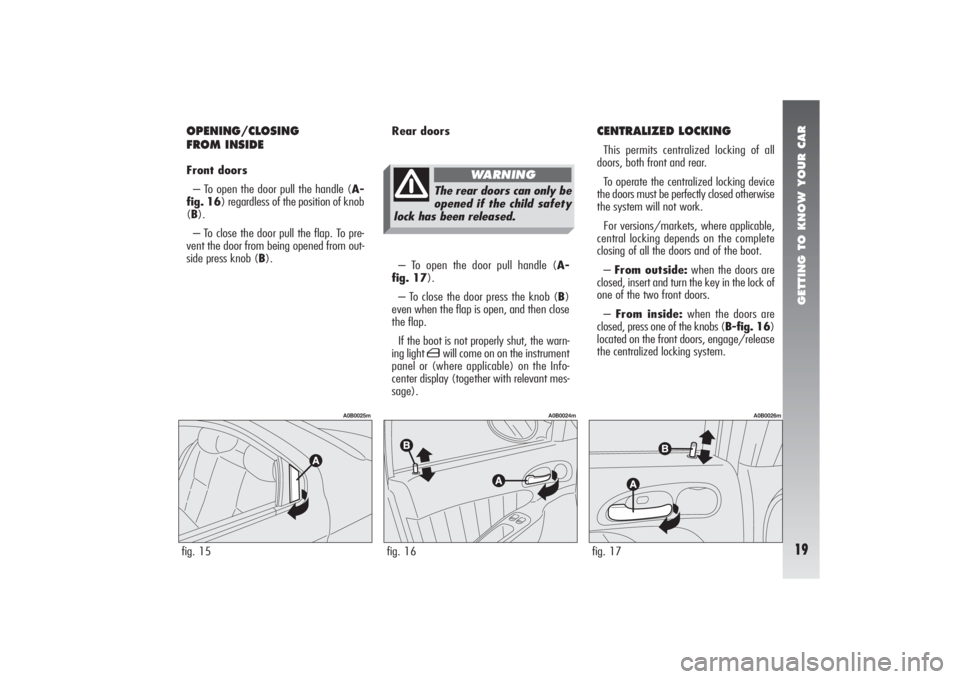
GETTING TO KNOW YOUR CAR19
OPENING/CLOSING
FROM INSIDEFront doors
– To open the door pull the handle (A-
fig. 16) regardless of the position of knob
(B).
– To close the door pull the flap. To pre-
vent the door from being opened from out-
side press knob (B).Rear doors fig. 15
A0B0025m
fig. 16
A0B0024m
fig. 17
A0B0026m
– To open the door pull handle (A-
fig. 17).
– To close the door press the knob (B)
even when the flap is open, and then close
the flap.
If the boot is not properly shut, the warn-
ing light ´will come on on the instrument
panel or (where applicable) on the Info-
center display (together with relevant mes-
sage).
CENTRALIZED LOCKINGThis permits centralized locking of all
doors, both front and rear.
To operate the centralized locking device
the doors must be perfectly closed otherwise
the system will not work.
For versions/markets, where applicable,
central locking depends on the complete
closing of all the doors and of the boot.
– From outside:when the doors are
closed, insert and turn the key in the lock of
one of the two front doors.
– From inside:when the doors are
closed, press one of the knobs (B-fig. 16)
located on the front doors, engage/release
the centralized locking system.
The rear doors can only be
opened if the child safety
lock has been released.
WARNING
Page 22 of 357
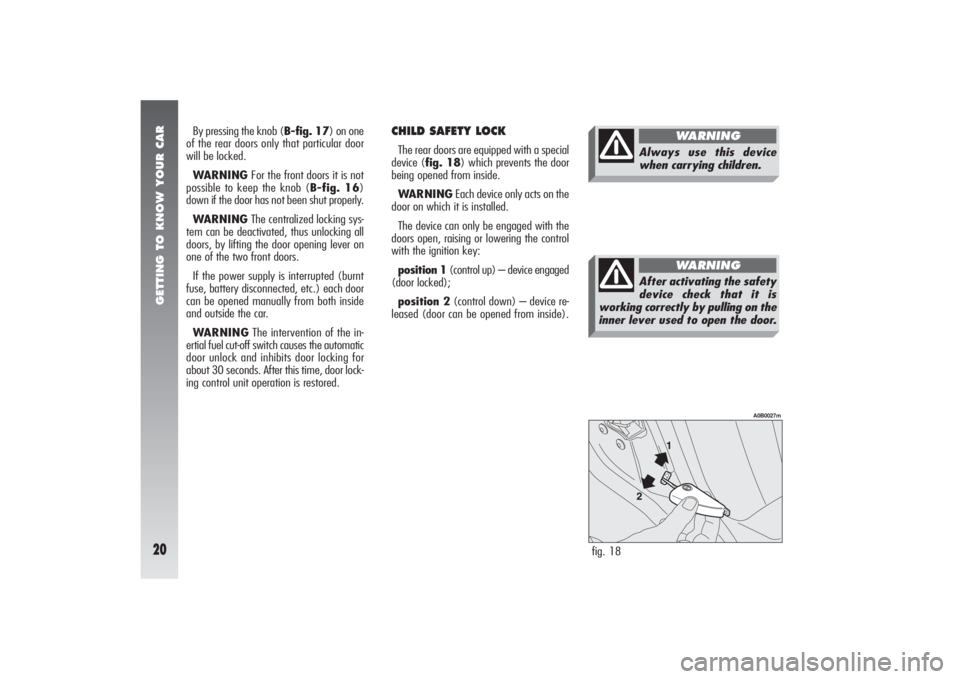
GETTING TO KNOW YOUR CAR20
CHILD SAFETY LOCK The rear doors are equipped with a special
device (fig. 18) which prevents the door
being opened from inside.
WARNINGEach device only acts on the
door on which it is installed.
The device can only be engaged with the
doors open, raising or lowering the control
with the ignition key:
position 1(control up) – device engaged
(door locked);
position 2(control down) – device re-
leased (door can be opened from inside).
fig. 18
A0B0027m
By pressing the knob (B-fig. 17) on one
of the rear doors only that particular door
will be locked.
WARNINGFor the front doors it is not
possible to keep the knob (B-fig. 16)
down if the door has not been shut properly.
WARNINGThe centralized locking sys-
tem can be deactivated, thus unlocking all
doors, by lifting the door opening lever on
one of the two front doors.
If the power supply is interrupted (burnt
fuse, battery disconnected, etc.) each door
can be opened manually from both inside
and outside the car.
WARNINGThe intervention of the in-
ertial fuel cut-off switch causes the automatic
door unlock and inhibits door locking for
about 30 seconds. After this time, door lock-
ing control unit operation is restored.
Always use this device
when carrying children.
WARNING
After activating the safety
device check that it is
working correctly by pulling on the
inner lever used to open the door.
WARNING
Page 23 of 357
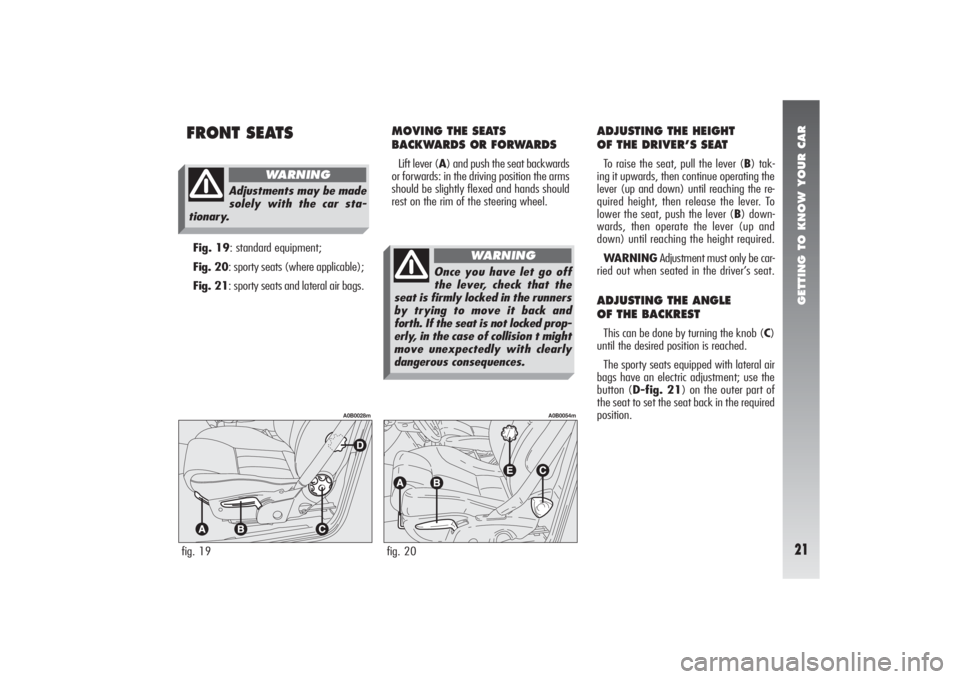
GETTING TO KNOW YOUR CAR21
FRONT SEATS
MOVING THE SEATS
BACKWARDS OR FORWARDS Lift lever (A) and push the seat backwards
or forwards: in the driving position the arms
should be slightly flexed and hands should
rest on the rim of the steering wheel.
ADJUSTING THE HEIGHT
OF THE DRIVER’S SEAT To raise the seat, pull the lever (B) tak-
ing it upwards, then continue operating the
lever (up and down) until reaching the re-
quired height, then release the lever. To
lower the seat, push the lever (B) down-
wards, then operate the lever (up and
down) until reaching the height required.
WARNINGAdjustment must only be car-
ried out when seated in the driver’s seat.ADJUSTING THE ANGLE
OF THE BACKREST This can be done by turning the knob (C)
until the desired position is reached.
The sporty seats equipped with lateral air
bags have an electric adjustment; use the
button (D-fig. 21) on the outer part of
the seat to set the seat back in the required
position.
fig. 20
A0B0054m
fig. 19
A0B0028m
Fig. 19: standard equipment;
Fig. 20: sporty seats (where applicable);
Fig. 21: sporty seats and lateral air bags.
Adjustments may be made
solely with the car sta-
tionary.
WARNING
Once you have let go off
the lever, check that the
seat is firmly locked in the runners
by trying to move it back and
forth. If the seat is not locked prop-
erly, in the case of collision t might
move unexpectedly with clearly
dangerous consequences.
WARNING
Page 24 of 357
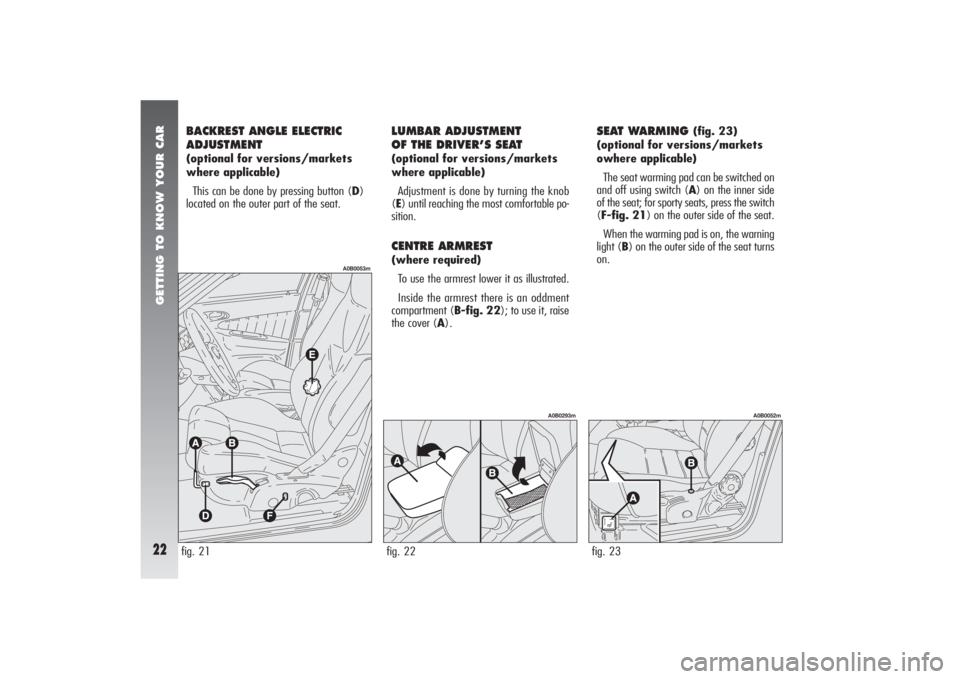
GETTING TO KNOW YOUR CAR22
BACKREST ANGLE ELECTRIC
ADJUSTMENT(optional for versions/markets
where applicable)
This can be done by pressing button (D)
located on the outer part of the seat.
LUMBAR ADJUSTMENT
OF THE DRIVER’S SEAT(optional for versions/markets
where applicable)
Adjustment is done by turning the knob
(E) until reaching the most comfortable po-
sition.CENTRE ARMREST (where required)
To use the armrest lower it as illustrated.
Inside the armrest there is an oddment
compartment (B-fig. 22); to use it, raise
the cover (A).
SEAT WARMING
(fig. 23)
(optional for versions/markets
owhere applicable)
The seat warming pad can be switched on
and off using switch (A) on the inner side
of the seat; for sporty seats, press the switch
(F-fig. 21) on the outer side of the seat.
When the warming pad is on, the warning
light (B) on the outer side of the seat turns
on.
fig. 22
A0B0293m
fig. 23
A0B0052m
fig. 21
A0B0053m
Page 25 of 357
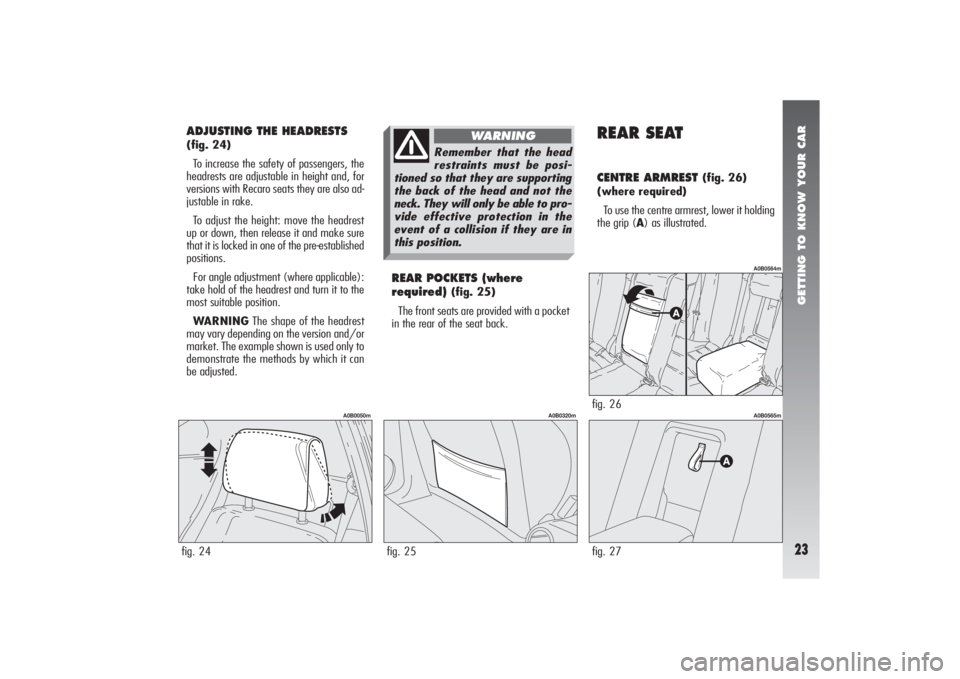
GETTING TO KNOW YOUR CAR23
ADJUSTING THE HEADRESTS (fig. 24)
To increase the safety of passengers, the
headrests are adjustable in height and, for
versions with Recaro seats they are also ad-
justable in rake.
To adjust the height: move the headrest
up or down, then release it and make sure
that it is locked in one of the pre-established
positions.
For angle adjustment (where applicable):
take hold of the headrest and turn it to the
most suitable position.
WARNINGThe shape of the headrest
may vary depending on the version and/or
market. The example shown is used only to
demonstrate the methods by which it can
be adjusted.
REAR POCKETS (where
required)
(fig. 25)
The front seats are provided with a pocket
in the rear of the seat back.
REAR SEATCENTRE ARMREST
(fig. 26)
(where required)
To use the centre armrest, lower it holding
the grip (A) as illustrated.
fig. 24
A0B0050m
fig. 25
A0B0320m
fig. 27
A0B0565m
fig. 26
A0B0564m
Remember that the head
restraints must be posi-
tioned so that they are supporting
the back of the head and not the
neck. They will only be able to pro-
vide effective protection in the
event of a collision if they are in
this position.
WARNING
Page 26 of 357
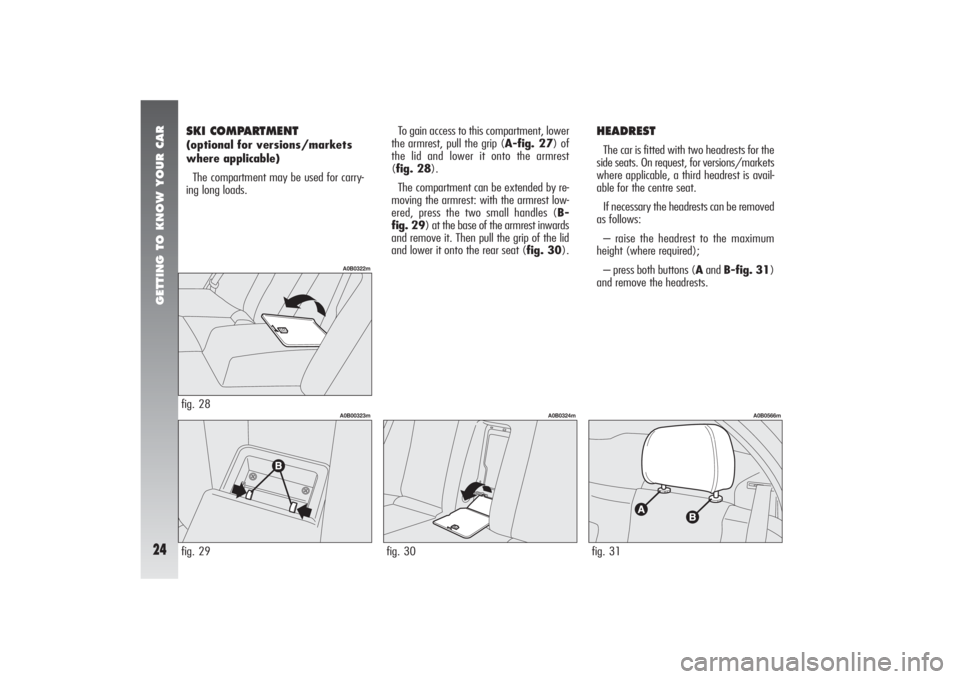
GETTING TO KNOW YOUR CAR24
SKI COMPARTMENT (optional for versions/markets
where applicable)
The compartment may be used for carry-
ing long loads.To gain access to this compartment, lower
the armrest, pull the grip (A-fig. 27) of
the lid and lower it onto the armrest
(fig. 28).
The compartment can be extended by re-
moving the armrest: with the armrest low-
ered, press the two small handles (B-
fig. 29) at the base of the armrest inwards
and remove it. Then pull the grip of the lid
and lower it onto the rear seat (fig. 30).
HEADREST The car is fitted with two headrests for the
side seats. On request, for versions/markets
where applicable, a third headrest is avail-
able for the centre seat.
If necessary the headrests can be removed
as follows:
– raise the headrest to the maximum
height (where required);
– press both buttons (Aand B-fig. 31)
and remove the headrests.
fig. 28
A0B0322m
fig. 29
A0B00323m
fig. 30
A0B0324m
fig. 31
A0B0566m
Page 27 of 357
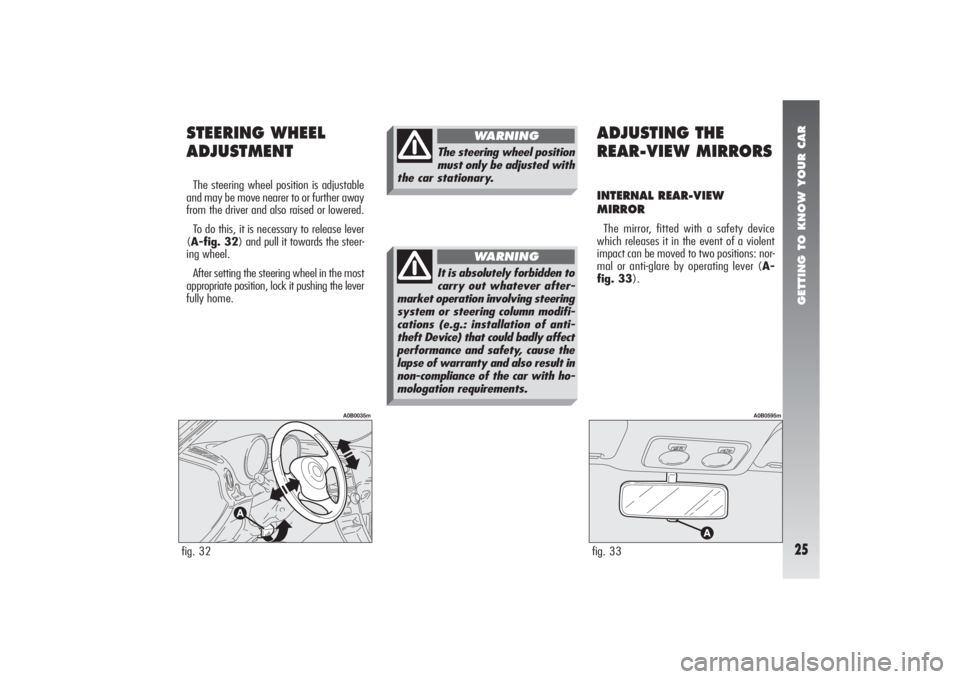
GETTING TO KNOW YOUR CAR25
STEERING WHEEL
ADJUSTMENTThe steering wheel position is adjustable
and may be move nearer to or further away
from the driver and also raised or lowered.
To do this, it is necessary to release lever
(A-fig. 32) and pull it towards the steer-
ing wheel.
After setting the steering wheel in the most
appropriate position, lock it pushing the lever
fully home.
ADJUSTING THE
REAR-VIEW MIRRORSINTERNAL REAR-VIEW
MIRRORThe mirror, fitted with a safety device
which releases it in the event of a violent
impact can be moved to two positions: nor-
mal or anti-glare by operating lever (A-
fig. 33).
fig. 32
A0B0035m
fig. 33
A0B0595m
The steering wheel position
must only be adjusted with
the car stationary.
WARNING
It is absolutely forbidden to
carry out whatever after-
market operation involving steering
system or steering column modifi-
cations (e.g.: installation of anti-
theft Device) that could badly affect
performance and safety, cause the
lapse of warranty and also result in
non-compliance of the car with ho-
mologation requirements.
WARNING
Page 28 of 357
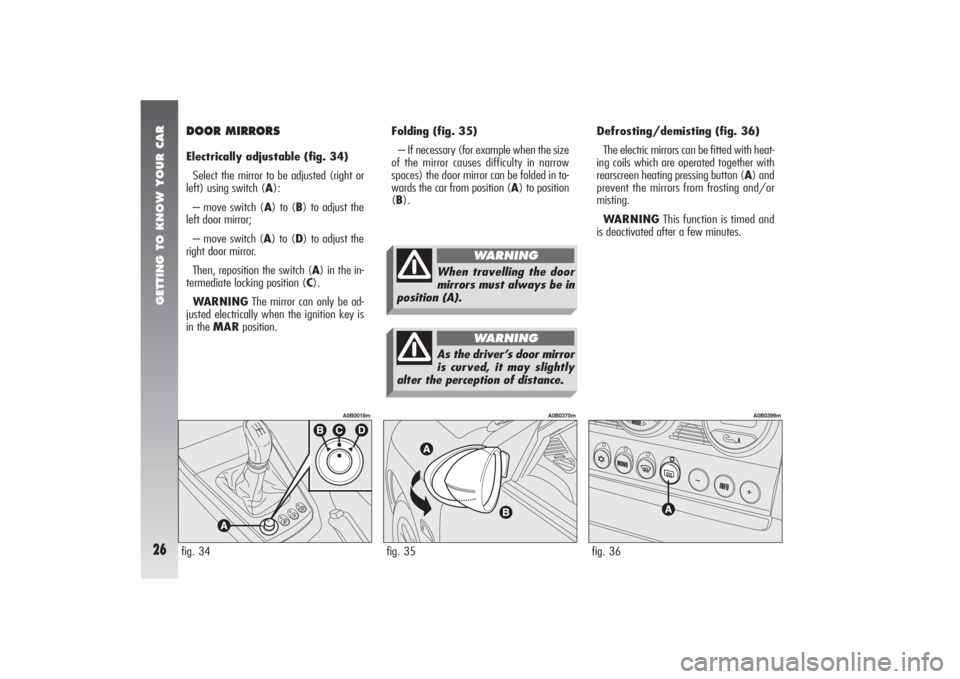
GETTING TO KNOW YOUR CAR26
Folding (fig. 35)
– If necessary (for example when the size
of the mirror causes difficulty in narrow
spaces) the door mirror can be folded in to-
wards the car from position (A) to position
(B).Defrosting/demisting (fig. 36)
The electric mirrors can be fitted with heat-
ing coils which are operated together with
rearscreen heating pressing button (A) and
prevent the mirrors from frosting and/or
misting.
WARNINGThis function is timed and
is deactivated after a few minutes.
fig. 36
A0B0399m
fig. 35
A0B0370m
When travelling the door
mirrors must always be in
position (A).
WARNING
As the driver’s door mirror
is curved, it may slightly
alter the perception of distance.
WARNING
DOOR MIRRORSElectrically adjustable (fig. 34)
Select the mirror to be adjusted (right or
left) using switch (A):
– move switch (A) to (B) to adjust the
left door mirror;
– move switch (A) to (D) to adjust the
right door mirror.
Then, reposition the switch (A) in the in-
termediate locking position (C).
WARNINGThe mirror can only be ad-
justed electrically when the ignition key is
in the MARposition.fig. 34
A0B0018m
Page 29 of 357
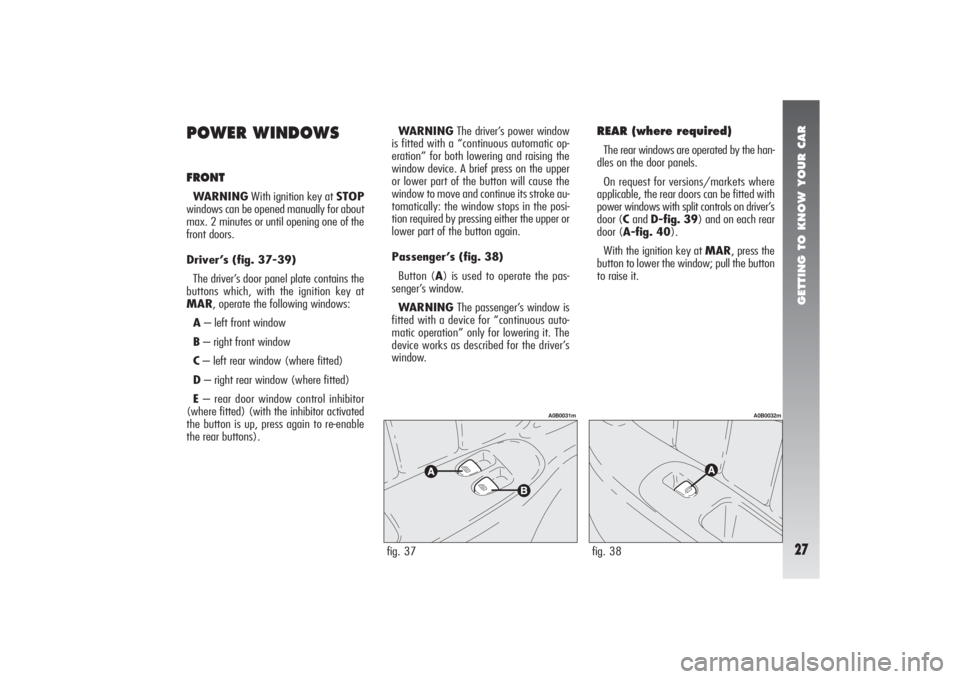
GETTING TO KNOW YOUR CAR27
POWER WINDOWSFRONTWARNINGWith ignition key at STOP
windows can be opened manually for about
max. 2 minutes or until opening one of the
front doors.
Driver’s (fig. 37-39)
The driver’s door panel plate contains the
buttons which, with the ignition key at
MAR, operate the following windows:
A– left front window
B– right front window
C– left rear window (where fitted)
D– right rear window (where fitted)
E– rear door window control inhibitor
(where fitted) (with the inhibitor activated
the button is up, press again to re-enable
the rear buttons).WARNINGThe driver’s power window
is fitted with a “continuous automatic op-
eration” for both lowering and raising the
window device. A brief press on the upper
or lower part of the button will cause the
window to move and continue its stroke au-
tomatically: the window stops in the posi-
tion required by pressing either the upper or
lower part of the button again.
Passenger’s (fig. 38)
Button (A) is used to operate the pas-
senger’s window.
WARNINGThe passenger’s window is
fitted with a device for “continuous auto-
matic operation” only for lowering it. The
device works as described for the driver’s
window.
fig. 37
A0B0031m
fig. 38
A0B0032m
REAR (where required)The rear windows are operated by the han-
dles on the door panels.
On request for versions/markets where
applicable, the rear doors can be fitted with
power windows with split controls on driver’s
door (C and D-fig. 39) and on each rear
door (A-fig. 40).
With the ignition key at MAR, press the
button to lower the window; pull the button
to raise it.
Page 30 of 357
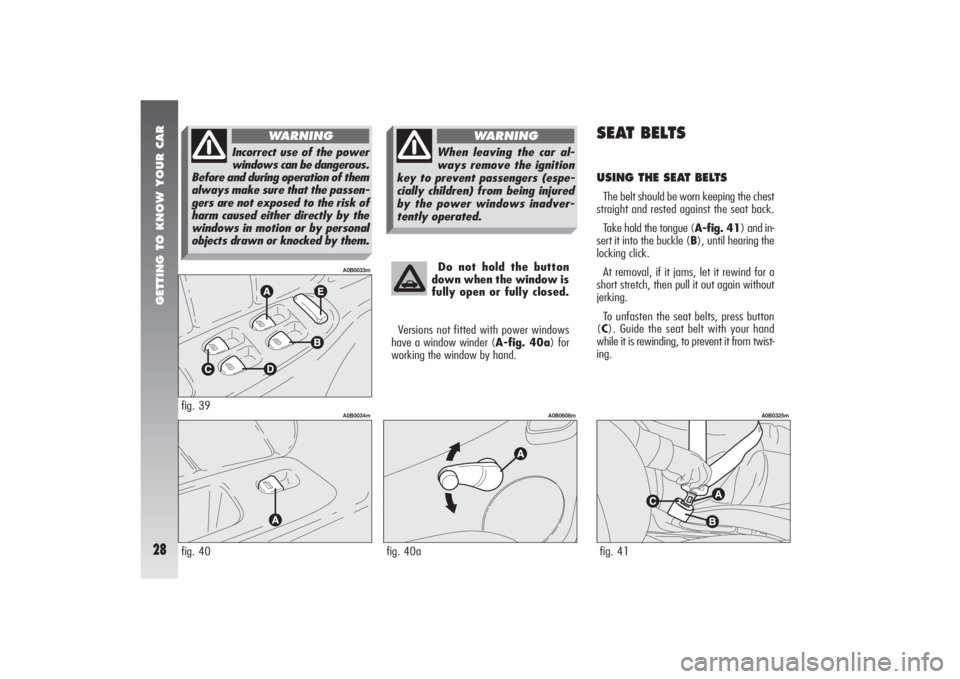
GETTING TO KNOW YOUR CAR28
Do not hold the button
down when the window is
fully open or fully closed.
Versions not fitted with power windows
have a window winder (A-fig. 40a) for
working the window by hand.
SEAT BELTSUSING THE SEAT BELTS The belt should be worn keeping the chest
straight and rested against the seat back.
Take hold the tongue (A-fig. 41) and in-
sert it into the buckle (B), until hearing the
locking click.
At removal, if it jams, let it rewind for a
short stretch, then pull it out again without
jerking.
To unfasten the seat belts, press button
(C). Guide the seat belt with your hand
while it is rewinding, to prevent it from twist-
ing.fig. 41
A0B0325m
fig. 40a
A0B0608m
When leaving the car al-
ways remove the ignition
key to prevent passengers (espe-
cially children) from being injured
by the power windows inadver-
tently operated.
WARNING
fig. 40
A0B0034m
fig. 39
A0B0033m
Incorrect use of the power
windows can be dangerous.
Before and during operation of them
always make sure that the passen-
gers are not exposed to the risk of
harm caused either directly by the
windows in motion or by personal
objects drawn or knocked by them.
WARNING